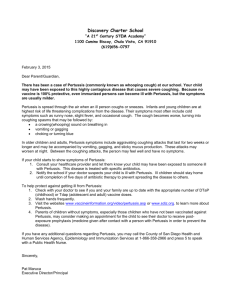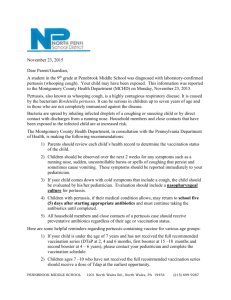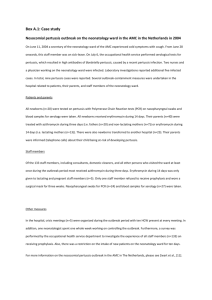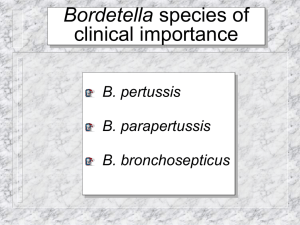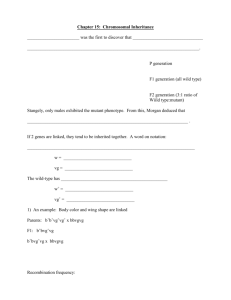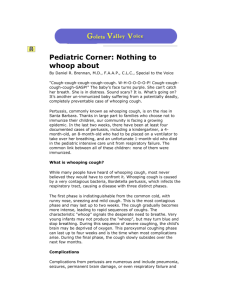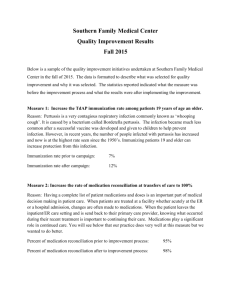David Blanco, PhD
advertisement
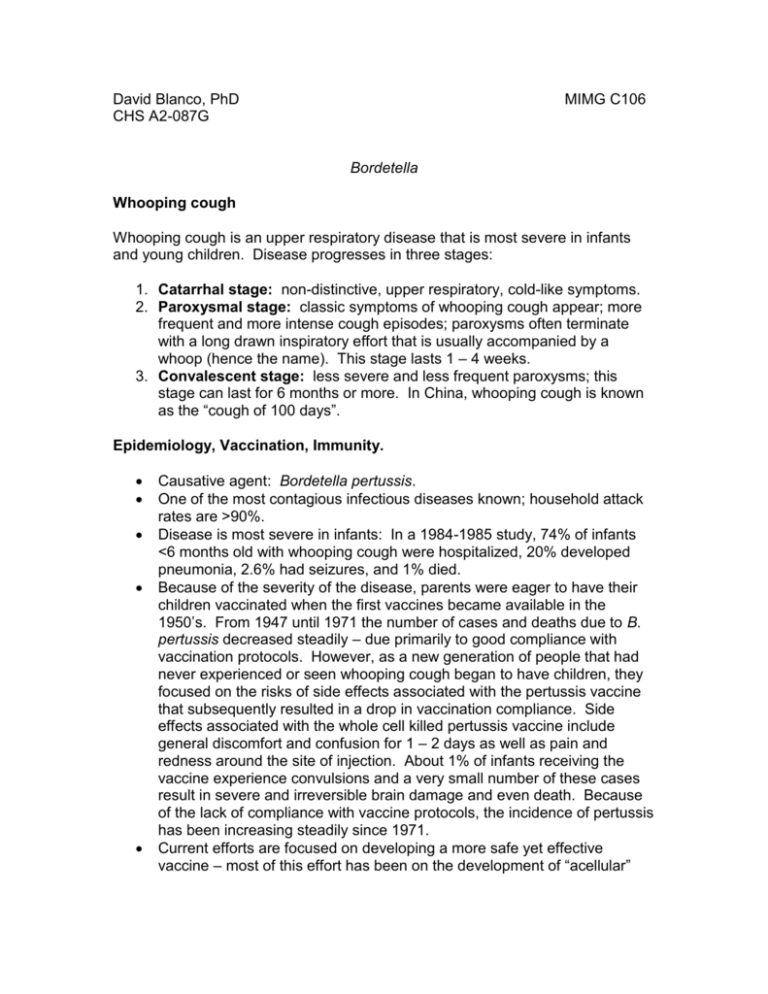
David Blanco, PhD CHS A2-087G MIMG C106 Bordetella Whooping cough Whooping cough is an upper respiratory disease that is most severe in infants and young children. Disease progresses in three stages: 1. Catarrhal stage: non-distinctive, upper respiratory, cold-like symptoms. 2. Paroxysmal stage: classic symptoms of whooping cough appear; more frequent and more intense cough episodes; paroxysms often terminate with a long drawn inspiratory effort that is usually accompanied by a whoop (hence the name). This stage lasts 1 – 4 weeks. 3. Convalescent stage: less severe and less frequent paroxysms; this stage can last for 6 months or more. In China, whooping cough is known as the “cough of 100 days”. Epidemiology, Vaccination, Immunity. Causative agent: Bordetella pertussis. One of the most contagious infectious diseases known; household attack rates are >90%. Disease is most severe in infants: In a 1984-1985 study, 74% of infants <6 months old with whooping cough were hospitalized, 20% developed pneumonia, 2.6% had seizures, and 1% died. Because of the severity of the disease, parents were eager to have their children vaccinated when the first vaccines became available in the 1950’s. From 1947 until 1971 the number of cases and deaths due to B. pertussis decreased steadily – due primarily to good compliance with vaccination protocols. However, as a new generation of people that had never experienced or seen whooping cough began to have children, they focused on the risks of side effects associated with the pertussis vaccine that subsequently resulted in a drop in vaccination compliance. Side effects associated with the whole cell killed pertussis vaccine include general discomfort and confusion for 1 – 2 days as well as pain and redness around the site of injection. About 1% of infants receiving the vaccine experience convulsions and a very small number of these cases result in severe and irreversible brain damage and even death. Because of the lack of compliance with vaccine protocols, the incidence of pertussis has been increasing steadily since 1971. Current efforts are focused on developing a more safe yet effective vaccine – most of this effort has been on the development of “acellular” vaccines comprised of purified bacterial proteins that are “protective immunogens”. Respiratory mucosal immunity. Bordetella are non-invasive, extracellular pathogens. They bind specifically to cilia of respiratory epithelial cells. To colonize the upper respiratory tract, pathogens must be able to resist or evade constitutive and adaptive immune responses effective at these locations. Constitutive defense mechanisms operative in the trachea include the mucocilliary escaltor and the antimicrobial action of macrophages and PMNs that survey the mucosal surface. Adaptive immunity at the respiratory surface is mediated by IgG + complement, mucosal IgA, and activated macrophages. Pertussis has traditionally been viewed as a two-stage disease; colonization followed by toxin mediated tissue damage. Two classes of virulence factors have been identified that presumably contribute to each of these stages. Bordetella virulence factors. Adhesins Filamentous hemeagglutinin (FHA) – a large (220 kDa) hairpin shaped molecule that is both cell-surface associated and secreted. FHA has been shown to be critical for tracheal colonization. Fimbriae (pili) – Important for tracheal colonization. Fimbriae exhibit phase variation. Pertactin – a 69 kDa outer membrane protein. Pertactin has RGD sequences suggesting an integrin attachment interaction. Toxins Tracheal cytotoxin (TCT) – This muramyl tetrapeptide is actually a fragment of peptidoglycan that is release from growing cells. In most other Gram-negative bacteria, this cell wall fragment is recycled and reincorporated back into peptidoglycan. Bordetella do not recycle this molecule because they lack the gene called ampG that is involved in the recycling process. TCT causes cytopathology and extrusion of ciliated epithelial cells from the mucosal surface of tracheal explants in vitro. Dermonecrotic toxin – causes necrotizing lesions when injected intradermally into mice. Its role in pertussis pathogenesis is unknown. Pertussis toxin – an A-B type toxin whose structure resembles that of cholera toxin (1 enzymatic subunits and 5 binding subunits). The S1 subunit catalyzes the ADP-ribosylation of an inhibitory G protein that down regulates adenylate cyclase activity. The result of pertussis toxin is therefore a dramatic increase in the intracellular concentration of cAMP. AC/HLY – this adenylate cyclase also has hemolytic activity. Once inside mammalian cells, AC/HLY is activated by binding to calmodulin and catalyzes the conversion of ATP to cAMP. Like pertussis toxin, therefore, AC/HLY results in a dramatic increase in the intracellular concentration of cAMP. The development of a genetic system for Bordetella. In 1984, Weiss and Falkow brought Bordetella research to the molecular genetic age by developing a genetic system for mutagenizing B. pertussis with Tn5. This system uses a suicide plasmid containing a colE1 ori (for replication in E. coli but not in Bordetella), Tn7, which encodes trimethoprim (Tmp)-resistance, spectinomycin (Sp)-resistance, and streptomycin (Sm)-resistance. The Tn5 encodes kanamycin (Km)-resistance. This plasmid is introduced into B. pertussis by conjugation and B. pertussis bacteria in which Tn5 has transposed into the bacterial chromosome are selected by plating on BG (Bordet-Gengou) plates containing Km and naladixic acid (Nal). The strain of B. pertussis used was resistant to Nal so Nal was used to select against the E. coli donors (E. coli is sensitive to Nal). Km-resistant colonies were then screened for sensitivity to Tmp, Sp, and Sm to differentiate true transposon mutants from bacterial in which the entire plasmid had integrated into the chromosome. Weiss and Falkow mutagenized B. pertussis and screened mutants for various phenotypes associated with virulence: 1. Hemolytic activity was assessed by looking visually for a zone of clearing around bacterial colonies growing on BG-blood agar. 2. Adenylate cyclase activity was determined by measuring [32P]ATP conversion to [32P]cAMP in the presence and absence of calmodulin in vitro. 3. pertussis toxin activity was assessed by measuring CHO cell clustering activity and by the ability of culture supernatants to cause histamine sensitization in mice. 4. dermonecrotic toxin activity was assessed by looking for dermonecrotizing lesions at the site of subcutaneous injection of B. pertussis cell extracts in mice. 5. filamentous hemagglutinin was assessed by measuring the ability of culture supernatants to agglutinate sheep red blood cells (srbc’s) and confirmed by Western blot analysis using anti-FHA antibody. 6. tracheal cytotoxin activity was assessed by determining the ability of culture supernatants to induce cytopathology in hamster tracheal organ cultures. Many mutants with defects in one or more of these virulence phenotypes were identified. Interestingly, All mutants defective for hemolytic activity were also defective for adenylate cyclase activity (It is now known that these two activities are performed by a single gene product – albeit different domains of the protein). No mutants defective for TCT were found. (as mentioned above, TCT is a fragment of peptidoglycan that is released because Bordetella lack ampG). How could you construct a strain that is deficient in TCT production? One mutant, BP347, was defective for expression of all of the virulence factors except TCT. It is now known that the transposon in this strain inserted into what is called the bvgAS regulatory locus. This was the first demonstration of trans-acting global regulation of virulence gene expression. The various transposon insertion mutants were tested for virulence by determining their ability to induce lethality in infant mice. Although the LD50s for the Ptx-, AC/HLY-, and vir(bvgAS-) mutants were increased compared to wild type B. pertussis, the LD50 for the FHA- mutant was not significantly different that of wild type. Does this mean that FHA is not a Bordetella virulence gene? Phase Variation versus Phenotypic Modulation. Two forms of virulence gene regulation have been identified in Bordetella: phase variation and phenotypic modulation. Phase variation is a metastable alteration between two genetic states. Phenotypic modulation is a reversible loss of virulence gene expression in response to certain environmental conditions. bvgAS encodes a two-component regulatory system. BvgS, the sensor, resides in the cytoplasmic membrane. Its large periplasmic domain is thought to be involved in signal recognition and is connected to three cytoplasmically located signaling domains by a region called the “linker”. Certain mutations in the linker lock BvgS in its active form. The three cytoplasmically located signaling domains include a transmitter, which autophosphorylates at a conserved histidine residue, a receiver domain, containing an aspartic acid residue that receives the phosphoryl group from the transmitter, and a C-terminal histidine phosphotransfer domain that is phosphorylated on a histidine residue. BvgA is a cytoplasmically located response regulator. Its N-terminal receiver domain is phosphorylated at an aspartic acid residue and its C terminus contains a DNA binding motif. BvgA-phosphate is competent to both activate and repress gene transcription. Is bvgAS responsible for Phase Variation? Stibitz et al., Nature 1989 At a frequency of about 10-3, vir- variants arise in a population of wild type B. pertussis. Within this vir- population, vir+ (wild type) B. pertussis will arise at a frequency of about 10-6. From these, vir- variants will again arise at a frequency of 10-3. To determine the genetic basis for this variation, Scott Stibitz took a lineage of strains, cloned their bvgAS loci from the chromosomes of each and determined the nucleotide sequences. It was found that in the region encoding the C-terminus of the BvgS receiver, there was a stretch of 6 cytosine (C) nucleotides. In all of the vir- strains, there were 7 cytosines. This addition of one nucleotide (C) caused a shift in reading frame such that the C-terminus of the protein encoded in strains containing 7 cytosine nucleotides differed from those containing 6 cytosine nucleotides – this rendered BvgS non-functional. Why was the frequency of mutation 10-3 instead of 10-6? The proposed mechanism is called slipped strand mispairing and it occurs in regions where there are long runs of single nucleotides, or where there are repeats of specific nucleotide sequences. Mispairing during DNA replication results in alterations in the DNA that, depending on where these alteration occur, can lead to alterations in the protein product that is ultimately produced. Is bvgAS responsible for Phenotypic Modulation? Phenotypic modulation in Bordetella is the phenotypic alteration between distinct phenotypic phases that occurs in response to specific environmental conditions. Under Bvg+ phase conditions (37oC and the relative absence of nicotinic acid and MgSO4) Bordetella express all of their virulence factors. In response to low temperature or the presence of nicotinic acid or MgSO4, BvgAS is inactive and virulence factors are not expressed. This is a phenotypic change – not a genotypic change. Mutational analyses had shown that bvgAS is required for expression of virulence genes. To determine if bvgAS is also responsible for the downregulation of virulence gene expression that occurs in response to “modulating” conditions, Miller et al. designed a strategy to find mutants that were insensitive to modulating conditions – i.e. mutants that expressed virulence genes even under modulating (Bvg- phase) conditions. 1. Setting up a selection scheme: Wild type B. pertussis (BP370) is hemolytic under Bvg+ phase conditions (- modulators) and non-hemolytic under Bvg- phase conditions (+ modulators) because AC/HLY is positively regulated by bvgAS. A ptx-cat fusion (cat encodes chloramphenicol resistance) was introduced into wild type B. pertussis. This strain (TOX35) is resistant to chloramphenicol (Cmr) under Bvg+ phase conditions and not under Bvg- phase conditions – because ptx is positively regulated by BvgAS. Deletion of bvgAS from this strain results in a strain (VIR101) that is never hemolytic and never Cmr. Providing bvgAS to this strain on a plasmid that integrates into the chromosome (strain VIR102) restores hemolytic activity and Cmr under Bvg+ phase conditions (cis complementation of the mutation). 2. Select spontaneous mutants. Plate VIR102 on BG + Nicotinic acid + MgSO4 (i.e. modulating conditions) + Cm. The following colonies were detected at a frequency of about 10 -6: CmrHLY+. However, some at the same frequency were CmrHLY-?. The goal was to find mutants in which BvgAS was insensitive to modulating conditions (Bvg-constitutive or Bvgc mutants). Since HLY is controlled by BvgAS, the colonies that were CmrHLY+ under modulating conditions must have been expressing HLY as well a PTX under modulating conditions – they were analyzed further. (Howver, what was the most likely explanation for the colonies that were CmrHLY-?). 3. Recover bvgAS from the chromosome of the Bvgc mutants. Triparental matings were used to recover the plasmids containing bvgAS from the chromosomes of the Bvgc mutants. These plasmids were called pVIR201, pVIR203, and pVIR204. 4. Reintroduce pVIR201, pVIR203, and pVIR204 into VIR101. To determine if the muations conferring the mutant phenotype localized to sequences contained on pVIR201, pVIR203, and pVIR204 (i.e. that they mapped to bvgAS), these plasmids were reintroduced into VIR101 and Cmr and hemolytic activity under Bvg+ and Bvg- phase conditions was determined: all plasmids conferred the Bvgc phenotype. 5. Test the ability of these mutant bvgAS loci to activate fhaB-lacZ expression in E. coli. bvgAS supplied in trans on a plasmid is sufficient to activate expression of an fhaB-lacZ fusion in E. coli and expression of this fusion is decreased when cells are grown under modulating conditions. The bvgAS loci contained on pVIR201, pVIR203, and pVIR204, also activated fhaB-lacZ expression in E. coli, but fhaBlacZ expression remained activated even when grown under modulating conditions. These bvgAS loci were therefore constitutively active in E. coli – providing further evidence that bvgAS mediates phenotypic modulation. 6. Subclone, test, sequence. The mutations conferring the Bvgc phenotype resulted from single nucleotide substitutions that caused single amino acid changes within the linker region of BvgS. One single nucleotide change was therefore sufficient to render BvgS insensitive to environmental conditions. Does Bvg function as an ON/OFF switch for virulence gene expression? Knapp and Mekalanos 1988, J. Bacteriology. Knapp and Mekalanos used TnphoA to mutagenize B. pertussis. Mutants were assayed for PhoA activity after growing cells under Bvg+ or Bvg- phase conditions. Three mutants, SK8, SK16, and SK75, displayed higher PhoA activity when grown under Bvg+ phase conditions compared to Bvg- phase conditions. These loci were called vag (vir-activated genes). This expression pattern is the same as all of the virulence genes that had been identified so far and, in fact, some of the genes identified in this study were those encoding previously identified virulence factors. Other mutants, however, displayed higher PhoA activity when grown under Bvg- phase conditions than Bvg+ phase conditions. These were called vrg loci (vir-repressed genes) and they represented a newly discovered class of genes – those that are negatively regulated by BvgAS. What is the role of Bvg-mediated signal transduction in Bordetella pathogenesis. Since B. pertussis has never been isolated from animal or environmental reservoirs, it has been assumed that the transition from the Bvg+ phase to the Bvg- phase may occur in the human host during infection and may be important for the development of infection. To determine experimentally the role of Bvg mediated signal transduction in the Bordetella-host interaction, experiments were performed using the closely related subspecies, B. bronchiseptica. This organism contains a nearly identical BvgAS signal transduction system and expresses a nearly identical set of virulence factors that are activated by BvgAS. However, this organism expresses different Bvg- phase factors than B. pertussis. Bvg- phase factors in B. bronchiseptica include motility, a siderophore, and urease expression. This subspecies also differs from B. pertussis in that it displays a broad host range, naturally infecting a variety of four-legged mammals including rabbits, rats, and mice. To determine the role of Bvg mediated signal transduction in vivo, mutant derivatives of wild type B. bronchiseptica that were locked into either the Bvg+ phase or the Bvg- phase were constructed and compared with wild type B. bronchiseptica in a rabbit model of respiratory infection. The Bvg- phase-locked mutant was, as expected, completely avirulent – it was unable to establish an infection even when administered at a dose of 10 6 cfu (4 logs higher than the ID50 for wild type B. bronchiseptica). The Bvg+ phase- locked mutant, however, was indistinguishable from wild type B. bronchiseptica in its ability to efficiently establish respiratory infection in rabbits (and other experiments have shown the same is true in rats and mice). When the antibody response to B. bronchiseptica infection was examined, it was shown that high titers of anti-Bordetella antibodies were generated in animals infected with either wild type B. bronchiseptica or the Bvg+ phase-locked mutant. The majority of the antibodies generated were directed against Bvg+ phase factors. Some were directed against factors that are common to the Bvg+ and Bvg- phases (i.e. are not regulated by BvgAS). In no case, however, were antibodies against Bvg- phase specific factors detected. Taken together, these results indicate that the Bvg+ phase is both necessary and sufficient for respiratory infection and strongly suggests that the switch to the Bvg- phase does not occur in vivo. So what is the role of the Bvg- phase? The Bvg- phase was previously shown to be necessary and sufficient for the ability of B. bronchiseptica to survive and multiply under nutrient-limiting conditions. This result suggests that the role of the Bvg- phase is to survive in an environmental reservoir. Thus, these data support the hypothesis that the role of BvgAS is to determine if the bacterium is within or outside a mammalian host and that the Bvg- phase may contribute to environmental survival. However, the human pathogen B. pertussis is only outside the host during transmission, therefore, the Bvg- phase may represent an evolutionary remnant not required for this now adapted human pathogen.

